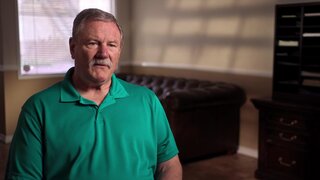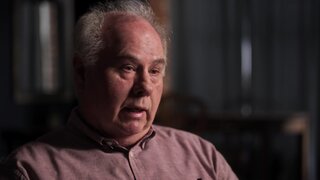Pawned Gems And A Fatal Curse: Who Murdered An Elderly Jewelry Salesman?
Detectives uncovered a family plot and a fatal prophecy after a jeweler, Mario Hernandez, vanished.
Jewelry salesman Mario Hernandez, 68, left his home in the hard-working community of Santa Ana, California on Friday, March 18, 2005 for a business meeting. He was never seen again.
On that day Hernandez took all of his gems with him, not just a sampling, according to Larry Yellin, a retired prosecutor with the Orange County DA’s Office. That wasn’t typical — and Hernandez was a man who always stuck to his routine.
“He loaded it all up into his van and went off to his appointments,” Yellin told The Real Murders of Orange County,” streaming now on Oxygen.com.
Hernandez had suffered a stroke and was taking medication so his granddaughter, Adriana Rodriguez, checked in with him throughout the day. She became concerned when he never responded to her calls.
When the elderly jeweler missed the family’s Friday night dinner her concern turned into alarm. “My first thought was he had a stroke somewhere,” said Rodriguez. She drove around looking for him and called the police.
Santa Ana Police Department officials told Rodriguez she’d need to wait 48 hours to file a missing persons report, so she launched her own investigation. She contacted her grandfather’s cell phone provider to obtain the last number he dialed. The number belonged to one of her grandfather’s clients, Rebeca Nivarez. She told police Nivarez said Hernandez was a no-show for the appointment.
When Hernandez was gone 48 hours, police filed a missing persons case. The official search for him and his van began.
“We start investigating every avenue, every person that he may have come in contact with, every phone number that might be related, every business client that he may have had,” said Jim Schnabl, a retired sergeant with the Santa Ana Police Department.
That included Nivarez, who had no useful information for police. Hernandez had seemingly vanished without a trace.
On March 23, investigators located Hernandez’s van in Mission Viejo, an area where he had no customers. “There was a strong smell of gasoline inside the van,” said William Lackey, a retired Santa Ana Fire Department investigator, adding that the presence of fuel suggested “an attempt to hide evidence.”
Police labeled the case a homicide, reported the Los Angeles Times.
Detectives collected evidence from inside the vehicle, including rope, empty jewelry boxes, and plastic gloves that were sent to the crime lab for analysis. The gloves were found to contain human DNA but detectives could not match it to anyone.
Investigators circled back to re-interview Nivarez, in hopes of finding a fresh lead. When they arrived at her home, her daughter, Claudia, answered the door. She informed them that her mother moved to Colorado on March 25. At the same time, Nivarez’s son, Ricardo Diaz-Nivarez, moved to Mexico.
The timing of the moves raised red flags for investigators. Another one arose when Claudia told authorities that before leaving her mother gave her a pair of earrings to hold for her. Detectives determined that they were from Hernandez’s missing collection.
Santa Ana police focused on local pawn shops and found that on March 18, the day Hernandez went missing, Nivarez sold about 20 pieces of jewelry for a grand total of $2,500.
Claudia Nivarez agreed to help the police. She gave a DNA sample to compare with the genetic material inside the gloves in evidence. “We recognize that the process to get DNA results is going to be time consuming,” said Schnabl. “It’s going to take several months.”
By December, Hernandez’s family was desperate for answers. Rodriguez checked in daily for a progress report from the Santa Ana Police Department.
An unexpected encounter jumpstarted the investigation. Claudia Nivarez ran into her mother in a Santa Ana supermarket giving out samples. She confronted her about Hernandez’s disappearance. Rebeca immediately abandoned her job at the market and couldn’t be found.
Eventually, it was confirmed the DNA on the gloves was a familial match to both Nivarez and Claudia. It belonged to Claudia’s brother, Ricardo.
As investigators searched for a motive for murder, Claudia revealed a conversation she had with her mother just before March 18, 2005. Nivarez said that a psychic told Nivarez that Hernandez had allegedly put a curse on her, according to “The Real Murders of Orange County.” The hex could only be lifted if he was dead.
“It is very common in Latino communities to seek out the guidance and advice of a palm reader … the same way that some people may follow the advice of their local priest or rabbi or teacher,” said Tricia Takasugi, a former television reporter. “There are other communities that follow the advice of a psychic.”
Nivarez told Claudia that Ricardo, who knew about the curse, was at her house on March 18 when Hernandez met with her. Ricardo confronted Hernandez, who, according to Nivarez, got aggressive and was killed by Ricardo in self-defense.
Working with police, Claudia reached out to her brother in Mexico and shared their mother’s version of the events. Ricardo’s response — “Why didn’t she just tell you the truth?” — was chilling, said Yellin. “The implication there is that there was no self-defense.”
Instead Ricardo “tells her that it was planned,” said Yellin.
Nivarez was tracked down in Anaheim, where she was charged. Ricardo was arrested in Mexico and was eventually extradited back to Orange County.
Ricardo claimed to investigators that Hernandez was arguing with his mother and grabbed her hair. Ricardo struck Hernandez with a golf club. When Hernandez pulled a knife to defend himself Ricardo wrestled it from him and stabbed him. To make sure Hernandez was dead he strangled him with a length of wire. Together the mother and son disposed of the body.
In separate trials, prosecutors were faced with the task of achieving two individual murder convictions. It was a rare example of prosecutors seeking to convict on murder charges in a case where no body was ever found.
The evidence showed that Hernandez left with all of his jewelry to sell, Yellin told producers. “To me that’s evidence there was a plan to rob him and probably a plan to kill him.”
On February 1, 2011, Rebeca Nivarez was convicted of homicide and robbery and sentenced to 25 years to life. Ricardo Nivarez was convicted of homicide and sentenced to 25 years to life.
Rodriguez refused to reveal the location of Hernandez’s body. “He just laughed and said, ‘I’m gonna take it to the grave,’” said Rodriguez. ‘You guys will never find it.’ How evil can you be?”
To learn more about the case, watch “The Real Murders of Orange County,” streaming now on Oxygen.com.























